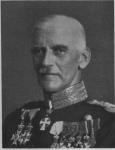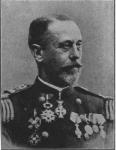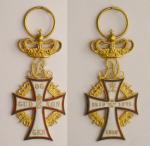-
Posts
1,232 -
Joined
-
Last visited
-
Days Won
9
Content Type
Profiles
Forums
Blogs
Gallery
Events
Store
Everything posted by Great Dane
-

Denmark Danish General Anders Gjedde Nyholm
Great Dane replied to mravery's topic in Northern European & Baltic States
Maybe it's possible to look him up in a list of RAO recipients? I wouldn't know exactly which one, but since it was possible to find him in an Oldenburg list, then maybe a Prussian similar one? /Mike -

Denmark Danish General Anders Gjedde Nyholm
Great Dane replied to mravery's topic in Northern European & Baltic States
Oh, I just saw your other thread where the RAO was mentioned... I do see your point: Maybe he was wearing his first 5 awards on the medal bar. That would make the last one the Russian Order of St. Anne - but I have great difficulties in identifying the 4th as an Anhalt Albrecht the Bear... (and it doesn't help there's a button in the way ) And the ribbon for the last award doesn't really match a St. Anne ribbon... P.S: I'm not sure I understand Jacky's point about Commander 1st. Class versus Grand Officer... Normally these class names are used to refer to the same class (just like Knight 1. class equals Officer) /Mike -

Denmark Danish General Anders Gjedde Nyholm
Great Dane replied to mravery's topic in Northern European & Baltic States
Mark, I very much doubt it. All the sources (Who's Who, State Calendars, Army List) have an Albert the Bear award and none mention a RAO award at all. What gave you that idea? /Mike -

Denmark Danish General Anders Gjedde Nyholm
Great Dane replied to mravery's topic in Northern European & Baltic States
The width of the ribbon is 27mm (has varied over time between 25 and 30mm but my mounted bars from the 1920s are 27mm). I have measured some dimensions shown below. The total length of the ribbon (measured while mounted) is 230mm, but you may want to experiment with, say, a paper ribbon before you start ordering ribbons. It is important to make the fold on the reverse (see picture). Without it you can't get a horizontal top (try it and see for yourself). Also note that the back vertical (double layered) part of the ribbon goes all the way down because the hook is mounted on this part. Let me know if you want more measures. /Mike -

Imperial Russia Russian officer photo - what's going on?
Great Dane replied to Great Dane's topic in Russia: Imperial
Good explanation Jerome, I should have realized that also the photography collectors demand played a role here. I guess I'm too focused on medals /Mike -

Denmark Danish General Anders Gjedde Nyholm
Great Dane replied to mravery's topic in Northern European & Baltic States
Actually, I don't know what the rules are (if any) for which Commander badge goes where (apart from the Dannebrog going around the neck), so that's an open question... Another thing: Koefoed was also awarded the Netherlands Oranje-Nassau order (Commander grade), and he is wearing it with swords on his right chest beside the Swedish Order of the Sword. So that confirms what Jacky said (not that I doubted it though... ) /Mike -

Denmark Danish General Anders Gjedde Nyholm
Great Dane replied to mravery's topic in Northern European & Baltic States
Weather is cloudy today, so no more ogling... These two gentlemen are the best I could find. First one is Major-General (Artillery) Ejvind Koefoed and the other is Navy officer Hans Peter Holm. As you can see, Koefoed has mounted his Commander badges on a trifold ribbon while Holm is using a more 'neck type' style (no, don't ask me how they are actually attached because I have no idea... ). Although regulations recommend that no more than two Commander badges should be worn around the neck at a time, 99% of the photos I looked at had only one. If wearing two badges around the neck and Dannebrog being one of them, Dannebrog should be on top according to regulations. Also, on all the photos I've checked no more than 2 Commander badges are worn on the top right side of the tunic - the rest is mounted down the side like on Holm's photo (note that a Navy tunic's buttons are closer together than on an Army tunic, but I think you get the idea) /Mike -

Imperial Russia Russian officer photo - what's going on?
Great Dane replied to Great Dane's topic in Russia: Imperial
George, Thanks for that information - amazing... I didn't know they were in such high demand... Now I know what to look for on my next flea market trip /Mike -

Imperial Russia Russian officer photo - what's going on?
Great Dane posted a topic in Russia: Imperial
I was following this eBay auction out of curiosity. Just wanted to check how it ended and almost fell from my chair...! What makes this photo worth more than $500? Is it 'just' the inflated prices we see on everything Russian these days or is there a better explanation? Is this guy famous? The auction is here Here is the photo for reference: /Mike -

Denmark Danish General Anders Gjedde Nyholm
Great Dane replied to mravery's topic in Northern European & Baltic States
PM sent (and no, I have no connection with the dealer ) Going rate for official crosses is around $1100-$1200 (normal condition) and around $900-$1300 for a Christian X Commander badge (depending on whether it is gold or silver gilt). /Mike -

Denmark Danish General Anders Gjedde Nyholm
Great Dane replied to mravery's topic in Northern European & Baltic States
Mark, If you're looking for an official cross for Nyholm, then these two models were both in use at the time Nyholm became Commander 1. class: Note the faceted interior and the two different rims. Also note the standardized lettering and crown (also seen on the privately purchased type you posted) which is typical for Michelsen. P.S: The cross at the right is for sale by a dealer (but has a small enamel damage in the upper left corner) /Mike -

Denmark Danish General Anders Gjedde Nyholm
Great Dane replied to mravery's topic in Northern European & Baltic States
Probably made by Michelsen (is there a 'AM' hallmark on it?). This type is not so unusual to find. A privately made Cross most likely from the beginning of the 20th century (embroidered crosses were in use until 1909 - anyone who wanted a metal piece had to have one made by a jeweler and many chose Michelsen who would later become the supplier of the official metal crosses). /Mike -

Denmark Danish General Anders Gjedde Nyholm
Great Dane replied to mravery's topic in Northern European & Baltic States
Ooops... my mistake... Insert Denmark, Order of Dannebrog (-> Commander 1. class) (unknown date)under the April 1925 heading. And thanks for the tempting invitation /Mike -

Denmark Danish General Anders Gjedde Nyholm
Great Dane replied to mravery's topic in Northern European & Baltic States
OK, I spent some hours at the library and this is what I came up with... Note that the month/year heading of each section is not the date of the award but indicates how his award list looked at that specific time. (each new section only lists additions or changes to the previous section) September 1901: Denmark, Order of Dannebrog (Knight) (18. Sept. 1901)1903:Mecklenburg-Schwerin, Greifen Orden (Knight)1906:Sweden, Order of the Sword (Knight 1. class)January 1908:Anhalt, Albrecht der B?r (Knight 1. class)Russia, Order of St, Anne (3. class)January 1909:Denmark, Order of Dannebrog, Silver Merit Cross (14. Jan. 1909)1912:Sweden, Order of Vasa (Commander)January 1913:Oldenburg, House- and Merit Order ('Offizierskreuz')April 1919:Denmark, Order of Dannebrog (-> Commander) (18. April 1919)April 1922:France, Legion d'Honneur (Commander)April 1925:Italy, Order of the Crown (Commander 1. class)Netherland, Oranje-Nassau Order (Commander 1. class)September 1928:Denmark, Order of Dannebrog (-> Grand Cross) (26. Sept. 1928)1934:Belgium, Order of the Crown (Grand Cross)Finland, Order of the White Rose (Commander 1. class)Finland, "Skyddsk?rernas F?rtj?nstkors"___ So his Oldenburg Cross was awarded before WWI so no wartime award (it was awarded in the second half of 1912), but you still have to find out if swords were added for military recipients. The same goes for the Anhalt award and the Russian St. Anne, doesn't it? Furthermore, we don't know if his St. Anne cross was awarded with bows or crowns or whatever they use over there... But I would say an educated guess would be a standard St. Anne with or without swords... NB! NB! NB! A note about the some of the orders and their classes: The lists I use to check his awards are not exactly easy to interpret. In a list from 1903 the possible Mecklenburg Greifen Order awards are plainly listed as: M.Gr. 1, 21, 22, 3, 4, 5 (no indication of what the classes are called) In this volume he is listed as having a M.Gr.4 In a list from 1922, the Greifen Order is listed as: M.Gr. 1, 2a, 2b, 2c, 3*, 3 = Grosskreuz, Grosskomtur, Komtur, Ehrenkreuz, Ritterkreuz mit Krone, Ritter. In that volume he is listed as having a M.Gr.3 = Knight without crown. I guess 'Ehrenkreuz' is the same as Offiziersteckkreuz. At least that would get it in sync with my Nimmergut list. For the Anhalt award, the list from 1908 shows: A.A.B. 1, 21, 22, 31, 32 = Grosskreuz, Komtur mit Stern, Komtur, Ritter 1. klasse, Ritter. In this volume he is listed as having a A.A.B.31 = Knight 1. class. His Oldenburg Order is the Offizierskreuz (listed very specifically...). The Russian Order of St.Anne is listed as: R.St.A. 1, 2, 3, 4 = 1., 2., 3., and 4. class. He is listed as having a R.St.A.3 = 3. class. I hope this clears things up a bit regarding some of the orders (I was getting a bit confused myself...) The other awards should be precise. /Mike -
-
Of the Christian VIII new type, the few I have seen on the market cost $3500-$5000 for a Knight Cross (I have never seen a Commander badge). The old type... hmm... hard to say... I own one of the two known pieces (there could be more of course), so do the math /Mike
-
Yes, the change of jeweler occured during the reign of Christian VIII (1839-1848), so both types exist with his cypher. /Mike
-

Denmark Danish General Anders Gjedde Nyholm
Great Dane replied to mravery's topic in Northern European & Baltic States
Mark, It's 72 degrees outside, the girls are wearing mini skirts and the smell of freshly brewed coffee is reaching me from my local caf?... but hey... how can that compete with sitting inside a dark and dusty library for hours... Unfortunately there are never any indications whether an award was with or without swords (probably because we never used swords ourselves). My only hope is to find out which year the different awards occured in his lists for the first time (so no exact award date either). The guy in the picture is King Frederik VIII (1906-1912). Yeah, I guess if he wears the Dannebrog Grand Commander (a special class for royalty only) he wouldn't want to 'pollute' it with inferior Commander crosses /Mike -
Hi Brian, Very nice cross indeed and pretty rare In the lifetime of the Dannebrog Knight crosses there were 3 changes. First one occured after the death of Frederik VI in 1839 where the reverse was changed so it would contain 'F VI' on the upper cross arm and '1808' was moved to the lower cross arm. Second one occured in the 1840s when the court jeweler changed to the present one (A. Michelsen) and the third occured - as you mention - in the beginning of the 20th century when the design was slightly changed (most visible on the 'C5' on the front). All the last 3 types are re-cyphered and reissued today. /Mike
-

Denmark Danish General Anders Gjedde Nyholm
Great Dane replied to mravery's topic in Northern European & Baltic States
Gents, Please don't take 1920 as a precise date. Some had copied what they saw foreign officers wearing etc. It's just that around 1910-20 it starts to be the norm to use medal bars. On Mark's picture: Around the neck: Dannebrog, Grand Commander On chest: Dannebrog, Silver Merit Cross Denmark, Commemorative medal for 2nd Danish-Prussian war 1864 Greece, Order of the Redeemer, Knight Unknown, maybe Russian? Is this Christian IX or Frederik VIII? (they both wore these kind of orders) He is wearing a foreign Grand Cross sash and Star (maybe in connection with a state visit?) /Mike -

Denmark Danish General Anders Gjedde Nyholm
Great Dane replied to mravery's topic in Northern European & Baltic States
Christian IX also wore his orders with the 'Danish trifold' ribbon (even on early pictures), so there was a bit of anarchy (or just no established procedure yet)... What is also interesting to notice is that not until approx. 1920 did it become normal to wear the orders and medals mounted on a bar. Until then they were just attached as singles. /Mike -

Denmark Danish General Anders Gjedde Nyholm
Great Dane replied to mravery's topic in Northern European & Baltic States
Thanks Brian , And remember that the Silver Merit Cross was awarded in high numbers (as a bravery award) during the two Danish-Prussian wars in 1848-50 and 1864 (i.e. the Frederik VII and the Christian IX versions). These crosses were mainly awarded to 'the common man' who wasn't used to wear orders and medals, so many of them kept the cross on a straight ribbon even after the 'fashion' changed. /Mike







